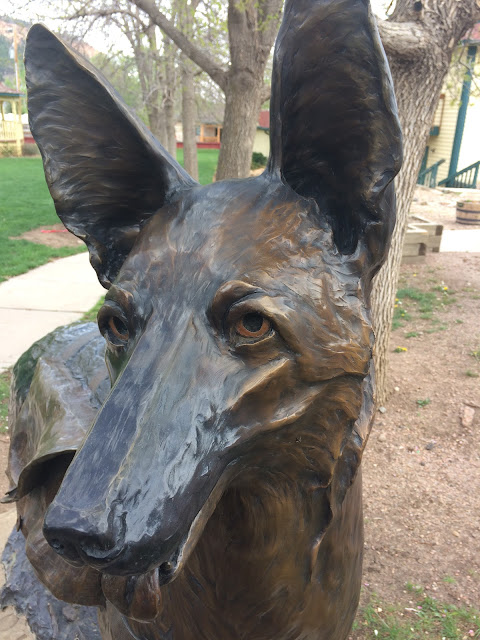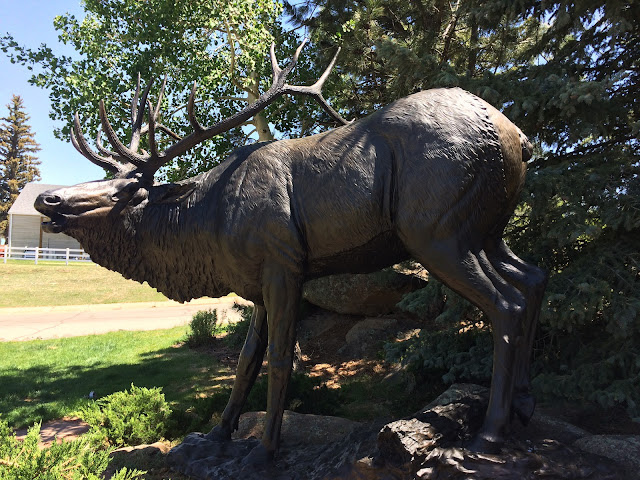 |
| Dizzy appears alert, awaiting his master's call to bring the next load of lights up the mountain. Author's Collection |
Warning: This may be part one of Dizzy's story. I have reached out to a couple of people in Palmer Lake (including the statue's artist) to learn more. If I hear back I'll add a new Dizzy entry.
I haven't had a chance to write here lately. I've been too busy. If you're actually following this blog regularly please accept my apology for the time you waited for this entry.
 |
| "Come Dizzy" Donna Arndt, Palmer Lake Historical Society 2006. Author's Collection |
I visited Palmer Lake recently to see the monument to Dizzy the dog. Dizzy is remembered with an amazing bronze in the small park between Palmer Lake’s Historic Society and Town Hall. Dizzy's statue is the finest, most detailed statue that I've seen so far in my quest to visit memorials to animals. Dizzy is also the first monument I've talked about to an animal that could be considered a beast of burden. Before I go into the details of the statue I should talk about what Dizzy did, and before I do that I need to talk a little about early Palmer Lake and the mood of the United States in the 1930s.
 |
| Dizzy stands at the ready. Author's Collection |
Palmer Lake is part of Colorado's Tri-lakes area, which lies between Denver and Colorado Springs. along highway 105 The other Tri-lakes towns include Monument and Woodmoor. The area is nestled into the foothills of Colorado's Front Range, where the mountains meet the plains. Before Interstate 25 was built along the Front Range Highway 105 was the best way to get between Denver and Colorado Springs. Hundreds of people passed through the area weekly in the 1920s and 30s.
In 1935 Palmer Lake resident and manager of the Mountain Utilities Electric Company, B. E. Jack decided to brighten the holidays of those travelers. by erecting a lighted star of Bethlehem on Sundance Mountain, which the small town rests at the foot of. This wasn't exactly a new idea. Lighted stars and crosses were popping up around the country thanks to two factors. The Great Depression and the expansion of electricity to rural areas. Jack was one of many around the country who expressed his religiously based optimism with modern technology.
 |
| Dizzy's statue faces Sundance Mountain. Author's Collection |
Jack enlisted the help of friends and neighbors to make his vision a reality. The star would likely bring new visitors, so the local business community supported its creation. One of his first volunteers was Bert Sloan, owner of the town's cafe. Sloan later remembered, in a Denver Post article, that the star was a bid, "to keep the town from dying," and "something we could be proud of for years to come." Sloan, Jack and a dozen local volunteers spent three months erecting the electrical base for the 500-foot star, which would support and power a series of lightbulbs to make if visible from the highway.
Dizzy is remembered because he helped carry light bulbs for this monumental effort. Dizzy was a German Shepard owned by Bert Sloan the cafe owner. Sloan made Dizzy a special backpack (which is represented in the sculpture) so the dog could help haul all the necessary equipment up the mountain. Dizzy's pack was loaded and with a whistle Sloan directed the dog to follow him up to the location the tools and equipment were needed.
So far I haven’t been able to locate any photos of Dizzy. While the event and of course the star have received quite a bit of local attention, the animal that labored as a part of the effort had been largely ignored. That’s not a big surprise; working animals, as necessary as they have been to our society and infrastructure, have been under-represented in history and public monuments. In 2006 the Palmer Lake Historical Society commissioned a sculpture of Dizzy after locating a handful of paragraphs about him in their archives. This was the town's first commissioned piece of art. Local sculptor Donna Arndt accepted the commission and began to work on the statue. There are no pictures of the dog so she worked from photos of other German shepherds to create the piece. I've attempted to contact the artist, but haven't received a response yet.
 |
| Dizzy's name tag. Author's Collection |
Dizzy's statue stands, about one and a half times life-size, in the park between Palmer Lake's town hall and historical society. In the sculpture Dizzy wears the backpack he was famous for and stands alert glancing up to Sundance Mountain where the star stands. His ears are erect and he appears to be ready to jump into action and carry his load up the mountain. His face is filled with the contentment of a working dog doing its job well. Dizzy's name tag and backpack are beautifully crafted with a realistic texture that makes the statue feel real. This is, so far my favorite site in my home state of Colorado.
 |
| Detail of the backpack strap. Author's Collection |
One thing I did notice that I found strange was the way the statue is described in Palmer Lake's information. Some of the news stories and press around the statue have claimed that the statue celebrates the spirit of volunteerism. This doesn’t fit into my thinking about how humans use animal labor. To me when animals work they do so to ensure they have food and shelter (basically the same reasons I work). Training helps to reinforce these connections between food and work for working animals. I would struggle to look at a sheepdog, a rodeo horse or a donkey and say that it was a volunteer. In the same vein I can’t believe that Dizzy had some higher purpose in his heart when he helped his master carry light bulbs. Helping Sloan was Dizzy’s job. His pay was food, shelter and companionship. This is the nature of working animals. It shouldn’t take away from the idea that they are family anymore than sending children out to do farm chores means that they are employees instead of family. But we should recognize that the motives of the master are not the motives if the animal.
 |
Dizzy, with the Historical society and library building
visible in the background. Author's Collection |
This discrepancy between how Dizzy and Sloan probably saw the situation and how we now remember Dizzy’s role points to something that I’ve been thinking about a lot since I started this blog. This is a case where the memory of an animal is filling a need for the community that the animal itself wouldn’t likely have been able to understand. Dizzy’s motives have been coopted by our own needs for a symbol. In our memories at least, animals can be whatever we require of them. In this case Palmer Lake wanted to recognize the work of volunteers (the historic society itself is a volunteer organization) and it looked back to the volunteers who placed the star that is now so much a part of the town. Dizzy was an unsung part of that story. In honoring Dizzy they thought (I assume) that they were honoring the most universally lovable of those volunteers. But they never thought to examine the difference in the motives of animals and humans.
 |
| Old Disappearance was preserved in 1922. Author's Collection |
Bonus: If you go to Palmer Lake to see Dizzy stop in the Lucretia Vaile Historic Society beneath the library to see another animal from Palmer Lake’s history. The taxidermied form of a mountain lion is displayed with the local newspaper’s account of his death.
The cat, nicknamed Old Disappearance was killed in 1922 by F. W. Simpson for a $25 bounty following the deaths of about thirty calves in the area. Old Disappearance weighed over 160 lbs. and measured eight foot, two inches from nose to tail tip.
 |
| Good boy, Dizzy! Author's Collection |
Sources:
Palmer Lake Museum & Historical Society exhibits
http://coloradocommunitymedia.com/stories/dizzy-statue-gift-to-town-for-historical-society-anniversary,82104
http://www.palmerdividehistory.org/
https://www.denverpost.com/2008/12/05/palmer-lakes-christmas-star-shines-on/












Comments
Post a Comment